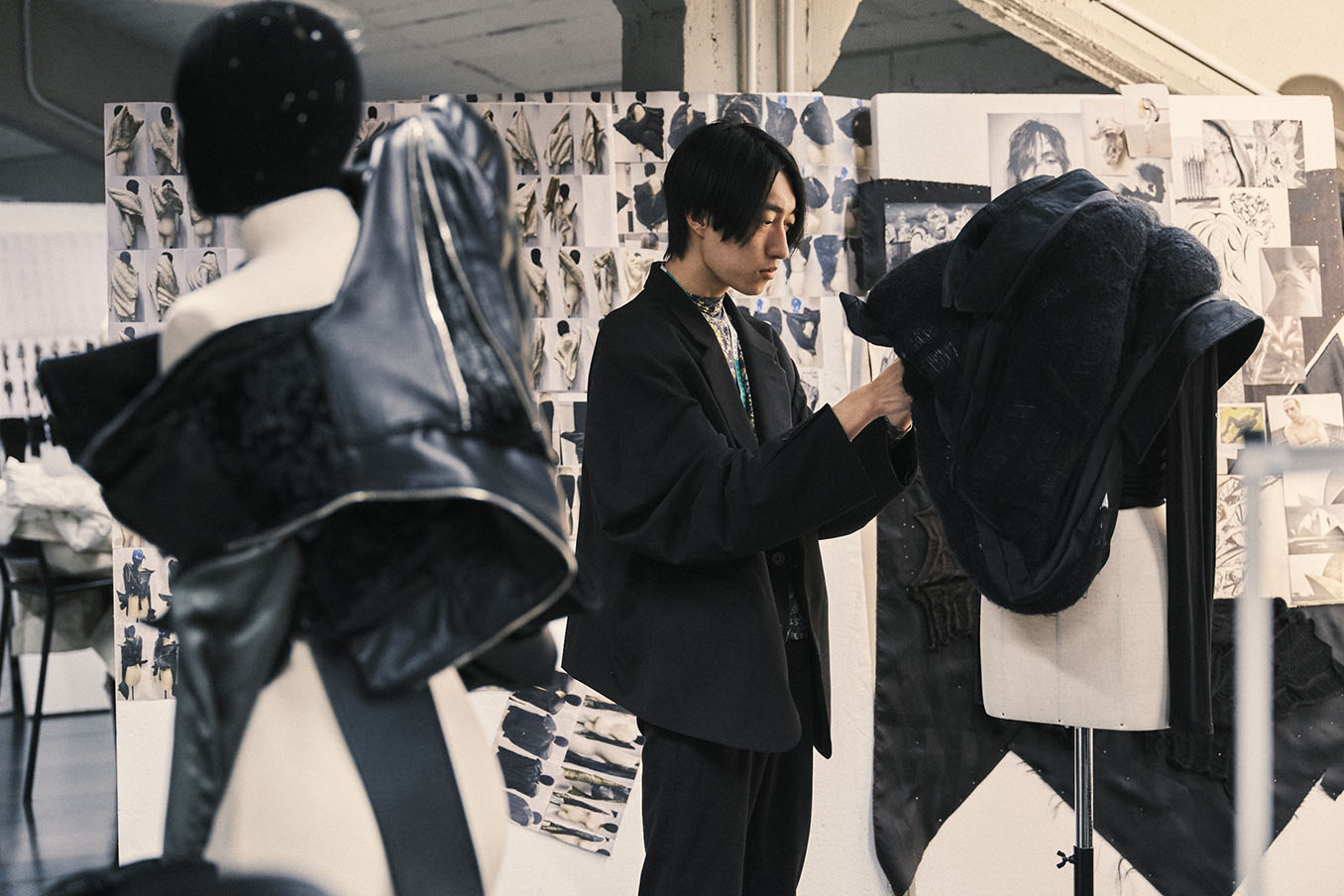When asked where he’s based, Sam Lewis chuckles, technically Melbourne, Australia, but since graduation, fashion design has taken him all over the world. From Paris to L.A. and everywhere in between — he’s got used to working anywhere.
Undergraduate in Fashion Design alumnus Sam Lewis’ graduate collection was daring and impactful, featuring large geometrical shapes that reference art history and religious archetypes as well as a diamond encrusted chastity belt. Now, a few years on from Polimoda, he has found himself as designer to stars like Chappell Roan, Julia Fox, Madonna, Yves Tumor and Lady Gaga, as well as collaborating with brands like Mowalola and Delfos, having his designs featured in Vogue Italia, Odda and Numéro, and on Naomi Campbell’s fashion4relief Emerge runway show.
Shaping the latest resurgence of gothic fashion, his work with Gaga has rightfully gained recognition and caused a media storm after her appearance at the Grammy’s in a custom made Sam Lewis gown. Equally, creating garments for the popstar in two of her latest videos has catapulted his visibility. He’s now looking towards the future, planning on presenting a new collection to the world under the moniker of his own brand.
Sam Lewis spoke to Phoebe Owston, editor of the Journal, about his journey since graduation, his plans for his own brand, new fashion design graduates and their relationship to sustainability, and of course, what it’s really like to work with Gaga.
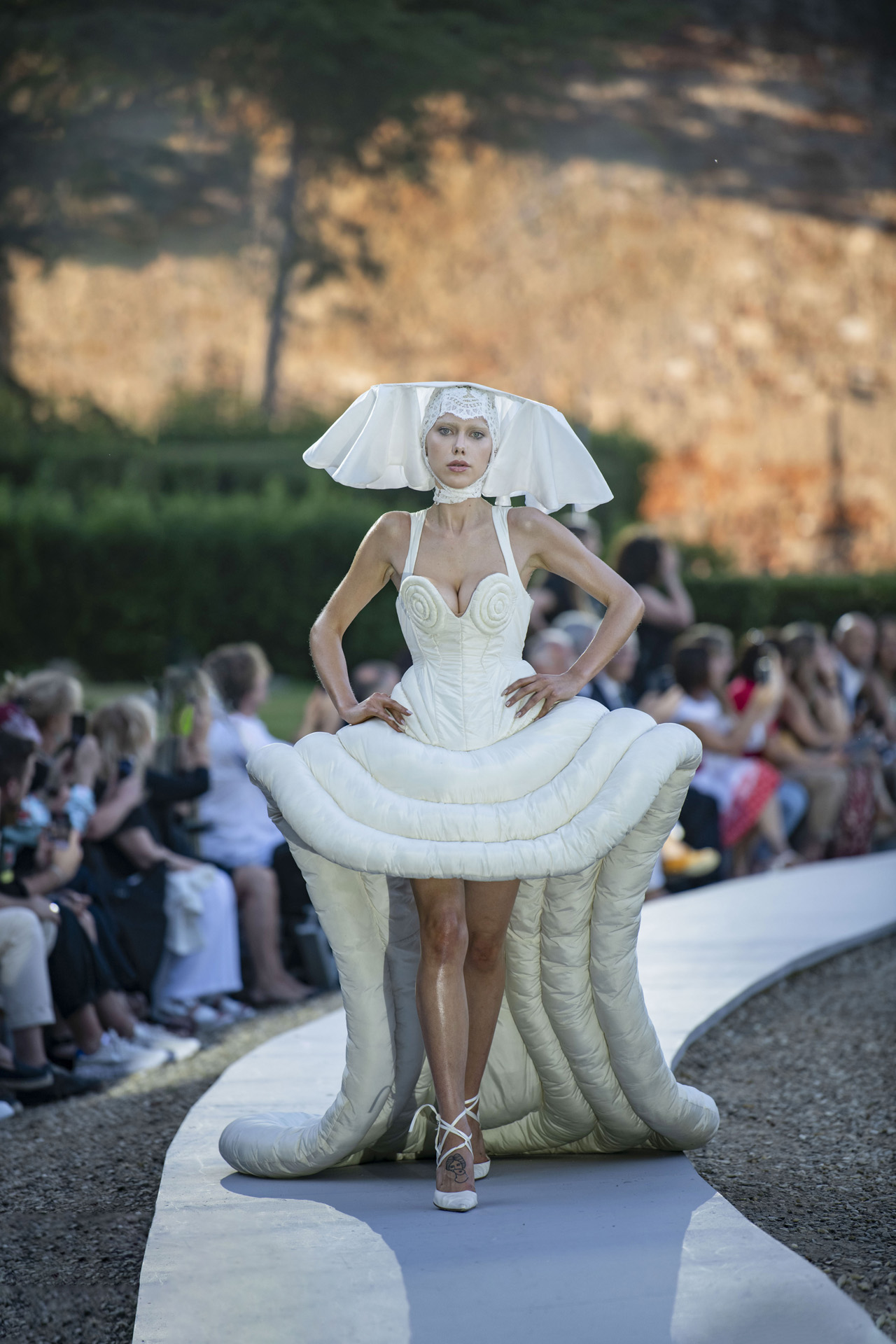

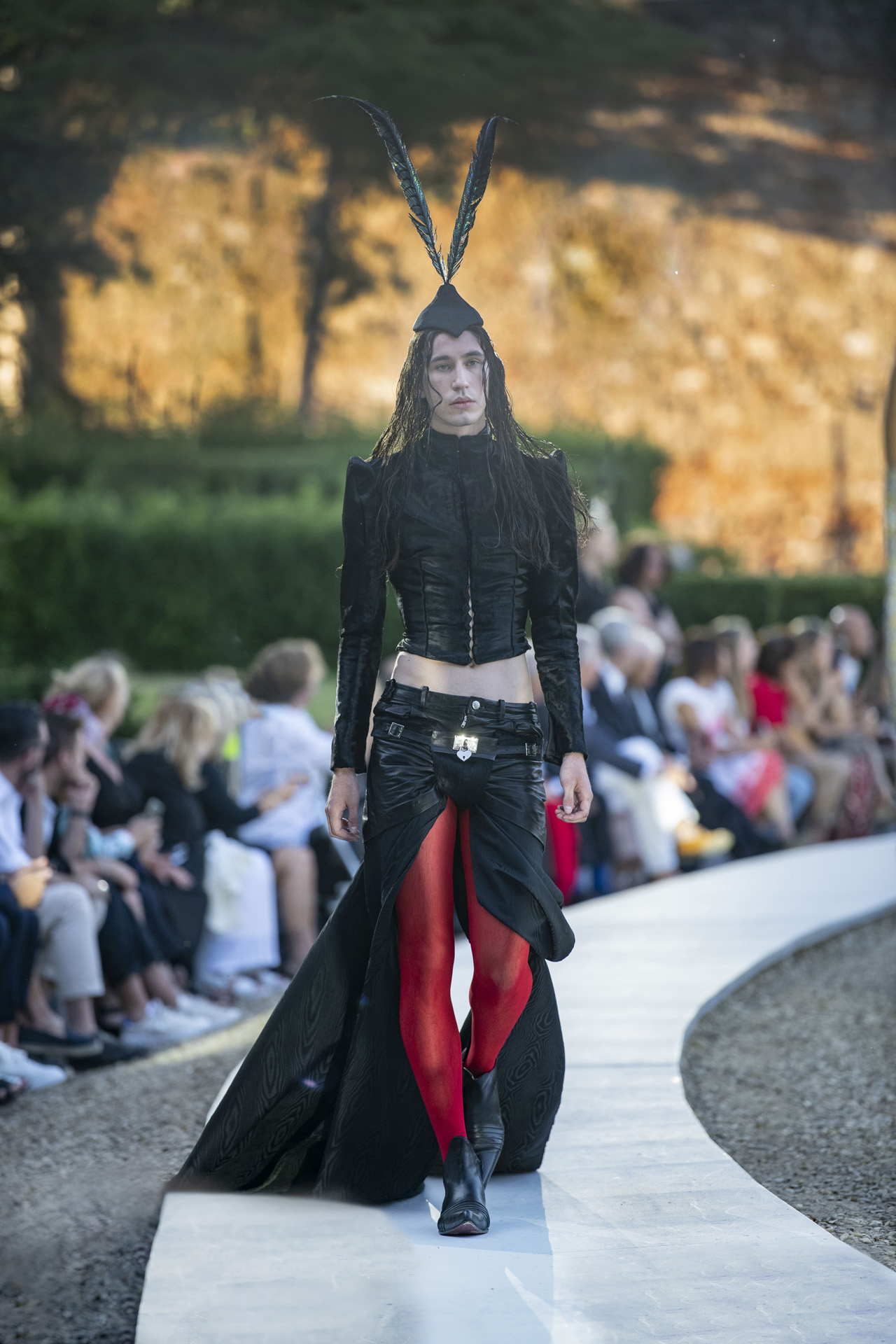
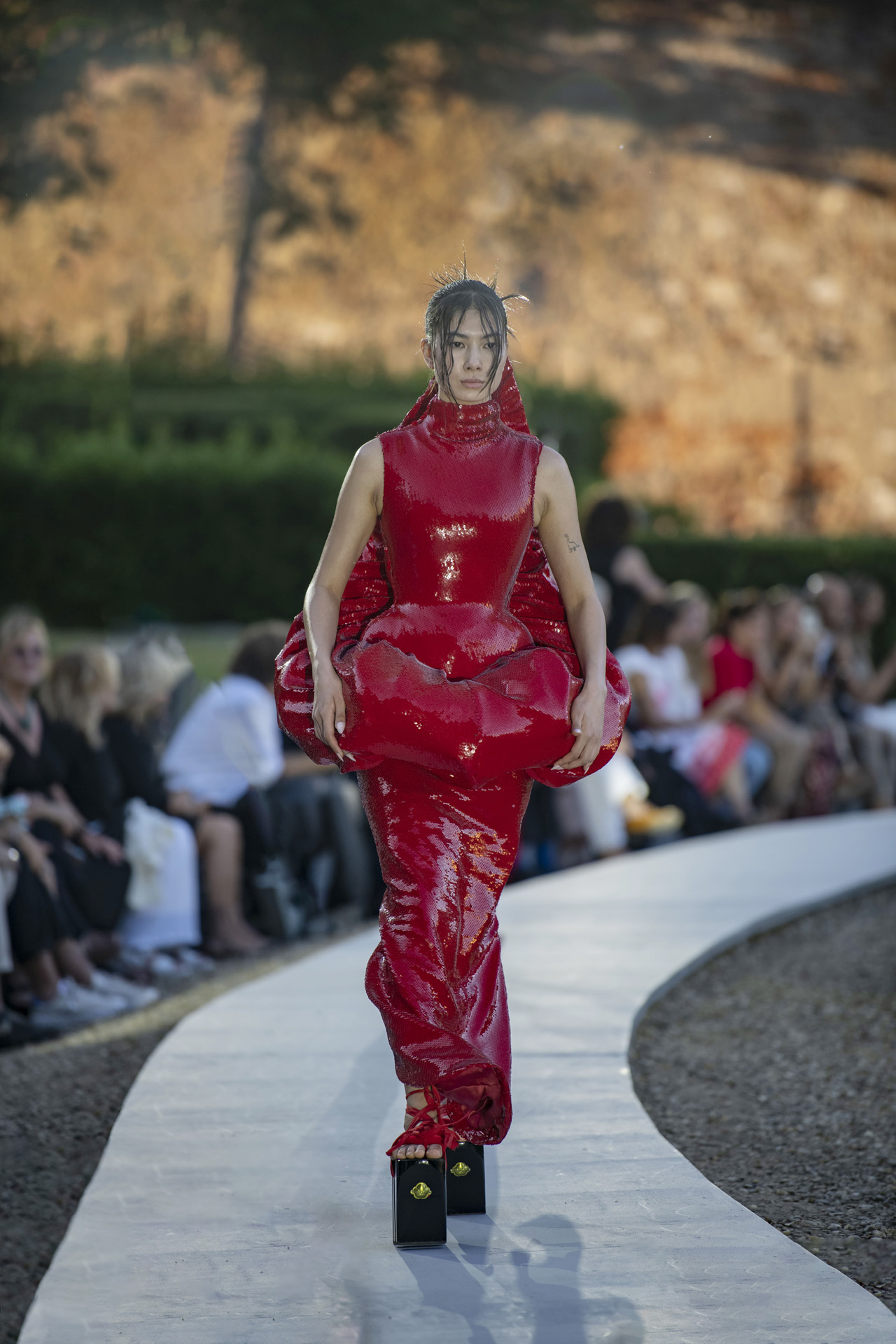
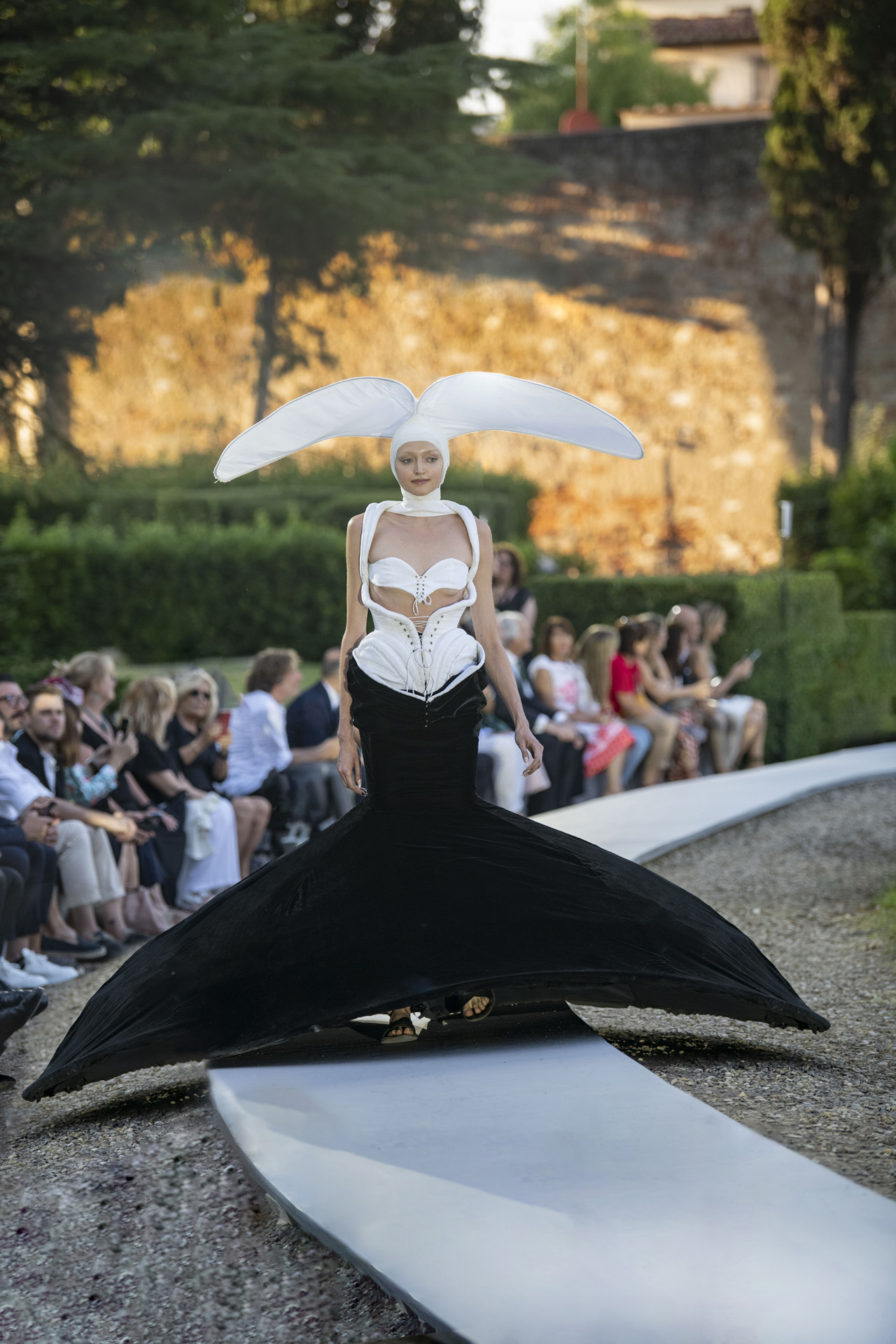
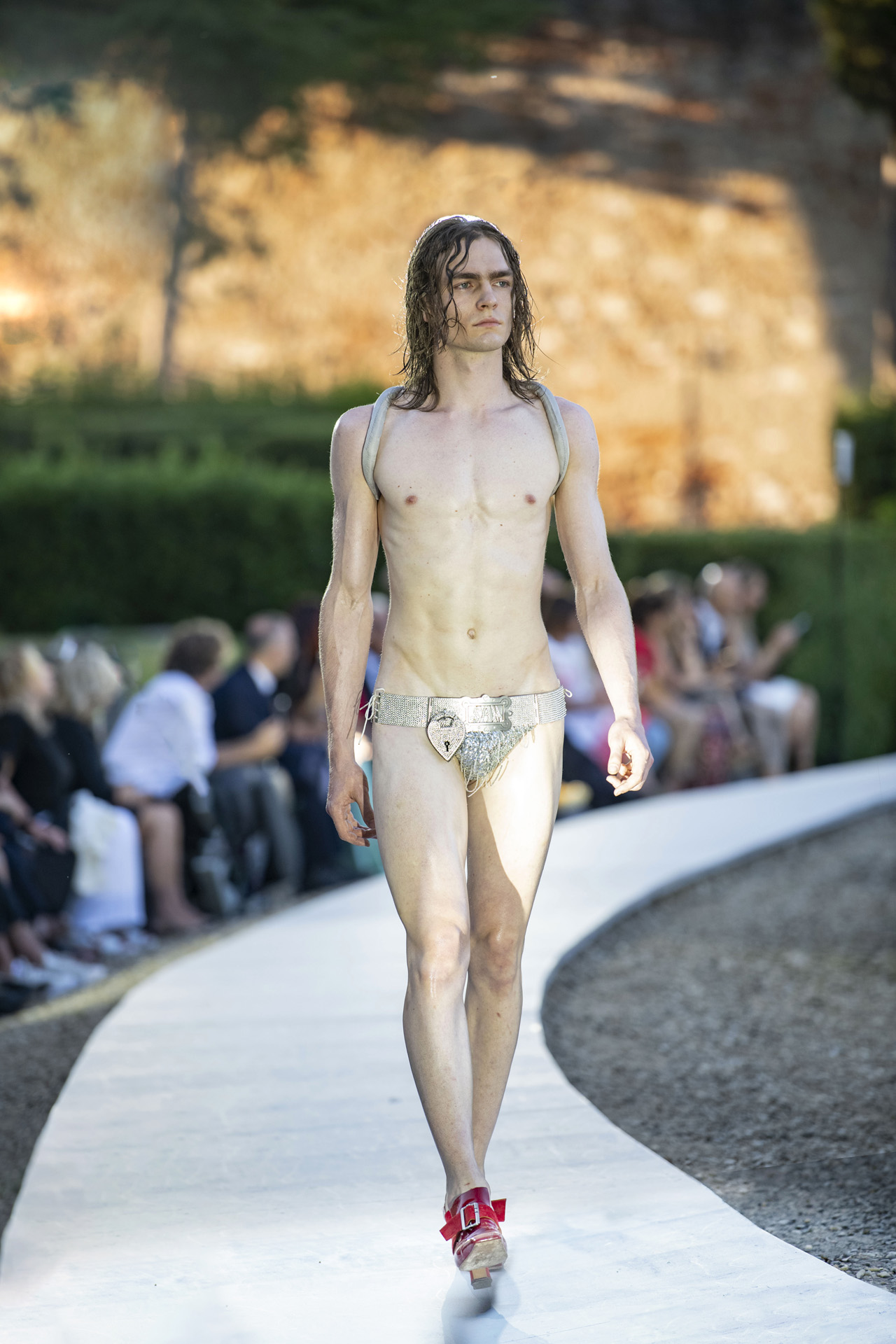
Phoebe Owston: How has life been since graduating?
Sam Lewis: A lot has happened, but mostly, it’s been a lot of figuring stuff out. People always say that after graduation is when you have to start organizing your life and starting to see what path you’re taking. Graduating from Polimoda, I had a really great time and a really sensational graduate collection, and I felt like I got quite a lot of attention from the work I did there.
Since then, it’s been a big journey of trying to find internships and jobs and then dealing with the disappointments of not getting those internships or jobs. Then finding my own way happily, finding a place and working for my own brand, and also working with a bunch of celebrities.
What kind of reception did your final collection get?
Mostly, while I was in school, I had been working with Mowalola, a London-based brand, and doing some custom work here and there. During my graduation show, I had quite a few friends from London and abroad who were reposting my work and sharing it online. From there, I think I started to gain a little bit of traction amongst some magazines and some talent incubation Instagram accounts.
I got quite a few requests for small comments or interviews from some publications. I did Perfect Magazine for their Instagram. There was some stuff for i-D Italy and Vogue Italia. It was pretty great.
How do you feel your design language evolved from when you started at Polimoda to when you finished?
I think it changed quite a lot actually. Starting school there, I always knew fashion was something that I wanted to do, but I think that growing up and figuring out what you like and dislike is a journey for everyone. Going through young adulthood sways your perception a little bit on what you truly love compared to what everyone else around you is feeding you images of.
Starting school, I was a little bit naive and I didn’t quite understand what the essence of my aesthetic was. That’s something I built throughout the four years there. As much as the school taught me, I think also the friends that I have, the people that I met along the way were paramount to figuring out my vision and what I really wanted to do with my work.
For creatives, that’s the whole reason you go to fashion school, to develop your visual language, your way of expressing yourself, at least for that moment. It will probably change throughout your life, but it’s where you lay the foundations for that.
I think so. It takes a lot for people to figure out what they want in life and figuring out, first of all, what path you want to take. For me, being a fashion designer, and then from there, figuring out what kind of story I want to tell and what kind of vision I want to bring to the world, and also what doesn’t exist already. There’s so much that exists in fashion that I think sometimes there’s such a big old block between so many creative identities and really narrowing in on what it is that makes you unique and what hole in the market you can fill or why your voice is worthy of attention, rather than the billions of others out there.
Those are the main areas of concern that I started to focus on in my third and fourth year. Especially after graduating, I started to put a lot more attention on what it is that I’m going to bring that can make me unique
So you were actively thinking about that?
Yes, I think that I’ve always had a pretty grand vision for myself. I’ve always been aware that it’s a big industry, and there are so many students coming out of so many schools every year.
The main thing is understanding that fashion is a gigantic industry, and that you’re not just competing or working around the people that are directly in front of you physically but also considering the industry as a whole and understanding that your work, even if you’re a student and not a designer or creative director of a gigantic brand, your work still has to exist in the same industry as them. How do you see yourself fitting into that is a big thing that I always believed in.
After you graduated, you previously mentioned that you were trying to find your feet, and trying to get internships and experience. What exactly did you do?
It was, honestly, quite a struggle for me to find an internship mainly because I wasn’t European. Being an Australian citizen and having to deal with this whole process of applying for internships, and a lot of the time, the work was either too much or too extravagant or the visa was a problem. There were always a million reasons why you weren’t the one chosen.
For me, I didn’t really feel it was necessarily a gauge of my talent or a gauge of my work, I always knew it was more kind of who’s there to do the work. I started to navigate my own path. I had been really, really lucky with the success of my graduate collection. I had many opportunities to work on custom garments for celebrities for events and things.
Even when the clothes didn’t get worn or the opportunity fell through, it was a nice signifier that the work was being appreciated and that there was another path for me. I started to embrace that more. As I was going, I was figuring out how it all worked as I went. I spent some time in Paris, after graduating, just for a year and I ended up working freelance for some brands.
I had a gig at Coperni for a bit, working for Fashion Week and stuff. I had worked for Mowalola as well previously in London. Just gaining little chunks of experience rather than having a full-on internship, which also let me have the free time to work on my own custom work with celebrities and things. It was a nice mixture of things that I got experience from.
How is your work structured? Do you work alone? Do you have a space where you predominantly work from?
At the moment, it’s still very much a small business. It’s just really me and my family and the seamstresses that I work with all around the world. I have been doing this on my own since everything has happened really quickly for me. As much as it’s been a fast thing to get used to, there’s also been a lot of hard work behind it. I’ve been preparing myself and my skills to be able to work on creating garments.
Recently I’ve been working with high-caliber celebrities, a lot of them have their own teams and their own people to work with. I’ve been lucky enough to be able to work with them. Being based in Melbourne, I fly a lot for work. I end up all around the world to create what I create. At the moment, it’s like I have my own workspace here, but then most of the time I’m not even working here, I’m in a different country altogether.
You’ve dressed Lady Gaga, most recently for the Grammys. How did that relationship come about?
Yes. I’ve worked with her on two of her videos for her new album and the Grammys now. It was actually really crazy because her stylists for this album are Nick Royal and Peri Rosenzweig. They’re a styling duo called HARDSTYLE. I’ve known them for a while, I think I had just finished my third year at Polimoda, in the summer between the third and final year. I was preparing my ideas for my graduate collection and getting ready for all of that. At the time, I had also been freelancing for Mowalola, from Italy. She put me forward to Nick, who was styling musician Yves Tumor. He really loved my work. He immediately contacted me and asked me to make some custom garments for Yves Tumor’s upcoming tour. Right at the start of fourth year, before I started working on my collection, I was working on these custom looks for Yves Tumor. That was my first ever custom order, and it was already with Nick. We kept in touch over the years, after graduation and stuff.
Nick and Peri had pulled more of my clothes. There were a couple magazine shoots, and more work for Yves Tumor. Then a couple months ago, Nick messaged me and asked, “Hey, we’re going to be doing a video for Gaga. Would you be interested in designing something for it?” It was a full circle moment of having known them for so long. This being the opportunity that finally brought us back together to create something really huge was really serendipitous, I gues
What is the process of working with a figure of that caliber? How does it work?
It’s really wild. Just working with Nick and Peri alone as stylists, I find them to be such amazing artists. They’re such creative identities in their own right. I think that’s probably the reason why Gaga was so keen to work with them for this era because they exist in this really gothic, dark fantasy world of fashion that is hard to come by. Working with them and with Gaga, she’s also such a creative and artistic person in her own right. She comes with so many ideas as well.
It’s normally very fast-paced because working on music video sets and working for such large-scale productions, so much is changing in the moment and so many ideas are put on the table that end up evolving into new things. Most of the time, by the time I get the call, there’s only a couple of days before we need a design solidified and things have to start getting made. It’s a really fast-paced environment, which I think happens in a lot of fashion.
As soon as Lady Gaga stepped on the red carpet, my phone started blowing up. As soon as she’s on the carpet, people are asking who she’s wearing, and they make sure to have the name down. That consisted of people finding my Instagram, me being tagged in a million things, and my followers doubled overnight almost. It was insane. I’ve seen how certain things can affect your mark on the industry, but this was my first experience with having such a large-scale thing happen.
Did you dress Lady Gaga in one of the pieces from a graduate collection, or a custom made piece?
Yes, all of the work that I’ve been doing for Gaga has been custom, so it’s all been specifically designed for her. Especially for the Grammy’s look and the looks for her latest video, Abracadabra, they were all rooted in elements of my signatures that I presented in my gradual collection. The look she wore to the Grammys was a direct reference to a jacket I had made in my graduate collection, and we had just reworked it using a similar shape and a similar pattern but in a new way that I felt represented my aesthetic more now.
One of the corsets she wears is directly inspired by one of the corsets I created in my graduate collection, just in a different color, in a slightly changed silhouette. Often your work as a designer in school when you get success for it, people tend to stay in that box and continue to generate the same thing. I like the idea of having those signatures there but evolving them so that they’re never the same. I think that allows you to grow more and show something a little bit new to the world.
How does the collaboration between celebrity and designer work?
Most of the time, as a designer, you’ll be contacted by a stylist who’s working with the celebrity, but in this case, since it is more of a creative project, being a music video, where the artist themself normally has a really big part in the overall vision of what gets created, I would first have to send the design to the stylists who then forward them to the creative team which includes Gaga, and from there, they would confirm which looks they were interested in.
In this case, for the most recent video, pretty much all of the looks I had designed were given the go ahead. They were like, “This is the vision.” I ended up flying to LA to work with them and to be there for fittings and to oversee the whole process of creating these looks because I’m just one set of hands. To create like 7 to 10 garments is insane within such a short amount of time.
Throughout the whole process, I was overseeing the work and making sure the vision was correct to the designs I had made. Then when it comes to fitting the clothing and selecting what gets worn, it’s all hands on, so that’s where I’m meeting with Gaga. I’m meeting with the stylists. We’re all in the room trying things on, seeing what works, what doesn’t, and then adjusting for changes in fitting.
Throughout the whole process, I’d meet her maybe three times, twice before the actual video. Then being on set for the video is a whole different thing. Being there as a designer who is there to oversee, to make sure the clothes look their best, is a whole thing. There’s so many parts of it.
What is Lady Gaga like as a person? Did you get along?
Yes, she’s very nice. Being someone that’s watched her since childhood and being such a fan, meeting your idol is always one of those things people say you have to watch out for. She was just as nice, amazing, creative, and generous with her time as I expected her to be. Being able to work with her and be in the same room as her and see her response to things was amazing.
She was always so complimentary of the work. Having worked with her multiple times now, she always remembers you. She’s always so nice to everyone. I don’t even know how she’s able to do it because it’s such a hard job to always be doing so much and to be performing at such a high level. She’s always got the time to be honest, which is amazing.
I was looking at your graduate collection and the various looks and pieces you’ve created since then. I noticed that, creatively and visually, the idea of an archetype is very present in your work. There are references to angels, to historical and religious figures, characters from art history, and from things you may see in paintings as well as renaissance or medieval influences. How important is that to your work?
It’s a really big part of my inspiration. I am mostly inspired by film and opera and historical art. I developed a love for that all throughout my life, but particularly when I was studying in Florence interacting with the city itself. I would go to a lot of museums, and I would engage with a lot of historical portraiture, and this historical energy really influenced my work.
I have always had a love for historical garments, costume, and the theatrical nature of design. My graduate collection was the first time that I really leaned so hard into these clear historical references. In my work now, I always try to find a way to modernize this sense of historical dressing. It’s something that I’ve always found interesting, and I represent it in the way that I dress. I felt that, for me, it was a really true place to draw inspiration from.
At the moment, there’s a lot of discourse in the fashion world around “crisis”, whether it’s the industry’s environmental impact, the current struggle in the luxury sector, or the job precarity that new graduates are facing. What do you think about all that and how do you approach it?
I think that there’s been a lot of unhappiness in the industry in general, just because of how interconnected everyone is now, and how easy it is to comment on things, the more voices you add, the more insane it gets really. There’s been this call to an older sensibility of design. There’s a yearning for this drama that we’re missing from the era of the ’90s when we had McQueen and Mugler.
There’s an aspect of my work which has really found a place in the more red-carpet and theatrical music video side of things. Just because you don’t find these are unique experiences, and in the commercial luxury landscape, you don’t tend to have these kinds of insane pieces coming out. If anything, there’s one or two per season. They only really exist in the couture space.
I never really wanted to pay attention to that whole race of making things to be worn by everyone and to sell. It’s been to my benefit and to my detriment. For a lot of years, I didn’t have a lot of money to spend because I wasn’t selling garments to the everyday person. I was selling them to the most important people at the most important events, and that only comes around every couple of months.
For me, it wasn’t really a conscious decision. It was more of a creative call. I don’t know how to describe it other than it was just something that I felt that I was good at. I spent my schooling focusing on the work that I do, which was based in corsetry and leather and gown making. I guess I subconsciously put myself on that path. I think it was the best path for me in the end.
As far as the industry as a whole, there’s so many new designers coming out all the time, and these huge brands create so much clothes every season. The idea of sustainability and whether this industry is even able to continue at the rate it’s continuing at, I’ve always taken a backseat in it. I feel that the work that I do doesn’t really exist in the same capacity as these luxury brands.
That’s not to say that I wouldn’t like to join it in the future, but I think that, as a young designer, and for a lot of young designers, we can’t really compete where we don’t compare. We don’t have billions of dollars behind us and never-ending teams of people to work. I think it’s more important for all of us to focus on what we can do immediately and to focus on our true creative voices, to be able to make something of ourselves.
That’s an interesting point of view. With fashion students especially, you go into this mechanism of going to fashion school, you come out and you do an internship, often at a big brand, and it’s this kind of machine. Instead, you are saying you recognized, early on, where your strengths lie and what you wanted to do creatively. By staying away from that, you are actually representing or embodying or working with values that are, by nature, sustainable or responsible. You are doing your work, as you said, with your family, with your seamstresses, and you follow your creative energy and motivation. You are not trying to make something that hundreds of thousands of people are going to wear.
Yes. Exactly. I think that’s something that I’ve always stood for. There’s been a lot of attention on this whole idea of sustainability because it’s such a buzzy word and a lot of people love to throw their hat into the ring of sustainability, but at the end of the day, sustainability is such a hard thing to achieve. A lot of what is technically sustainable is all just greenwashing.
Nothing is really changing, but the image of what we see seems to be changing. For me, I always thought that, as long as I’m making what I’m making, I don’t need to feel this overall urge to be particularly sustainable. It already exists in any young designer’s work based on the capacity that they work at. We’re all individual people working on small things.
Especially going to school in Italy, the way we would have materials provided from dead stock of brands and I would also recycle historical garments or reuse pieces of things. Working in that smaller capacity was a way to become more sustainable. I think that it was also difficult, because while you’re in school a lot of competitions for younger designers love to focus on this idea of sustainability.
I always found it to be quite strange that we, as young designers, were the ones that had to, all of a sudden, focus on being sustainable. Even being in the room at some of these competitions in different countries, we would talk to these gigantic factories and they would show us a video about sustainability and then not tell us what they were doing to be sustainable.
I remember another student asked them, “What are you doing to be sustainable then?” The guy was like, “You guys are the new designers, so this is to show you that sustainability matters.” We thought, “To push it onto us is just another part of the problem, to expect the younger generation to come in and sweep away all of this when this industry has been around for such a long time and it’s going to be here for so much longer after we leave, that we don’t think it’s really a thing that we should be tackling on our own.” I think there’s a bigger problem.
What about the future? Do you have any plans or ideas as to where you want to take what you are doing?
For a while now, my goal has been to start my own brand. All of this stuff that’s been happening recently has been fuel for the fire to get that going. A lot of the work that I’ve been doing with Gaga and other celebrities have been ideas taken out of a larger collection of work that I’ve been chipping away at as I go.
This year, I plan to release a new collection, and it’s a collection that I’ve had the idea for, ever since graduating from school. It’s been three years in the making, at this point, just in my mind. I’ve been tackling that and figuring out what it means to be a brand at this point, and what it means to be a designer that represents yourself. That’s where I see myself headed in the future.
I’m really excited to have some new work to show. Especially since I’ve been living off of the work that I did in school, everything I’ve done so far has been an extension of my graduate collection, so I’m really excited to show the evolution. I think that a lot of people that leave school, they all wish they could do things differently, and it’s almost as if immediately after you finish your graduate collection, there’s so many things you would’ve changed.
Do you have any advice for current fashion students?
I think the main thing is that I had a really unique path after graduation that not many people understand to be a path. As you mentioned before, a lot of students go about the route of finding an internship and a job, and working from 9-5 at large brands.
For the longest time, that was my dream too. I tried really hard to make that happen for myself. The thing that people don’t talk about often is the oversaturation of designers in the industry. It’s amazing that all of us want to study fashion and we all want to be part of this industry we’ve learned about for so long, but there are really hard realities to graduating and trying to enter a workforce that is so rooted in a historical industry that’s full of a lot of people.
As I mentioned before, even if you’re the best person for the job, you won’t always get the job. I watched a lot of opportunities I thought that were meant for me pass me by. The biggest thing that I learned through all of that was, no opportunity that is meant for you will ever pass you by. It’s a situation where you will always get what is meant for you. For new graduates, it’s a thing of understanding there’s a million paths to get to your end goal.
The people that succeed are the ones that keep trying for it. Creating a voice that’s uniquely your own is the most important thing to think about. I think that, being in school, I met a lot of people that I thought, “Maybe this isn’t for you,” because we were all working really hard hours. I think that this industry is not meant for people that don’t have the work ethic to put in the long hours, and live and breathe fashion. We do anything we can to make our vision a reality. People should always have that attitude about their work.
